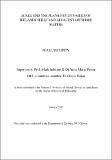| dc.contributor.advisor | Johnson, Mark | |
| dc.contributor.advisor | Power, Anne Marie | |
| dc.contributor.author | McGinty, Niall | |
| dc.date.accessioned | 2015-03-13T19:05:29Z | |
| dc.date.available | 2015-03-13T19:05:29Z | |
| dc.date.issued | 2012-01-26 | |
| dc.identifier.uri | http://hdl.handle.net/10379/4896 | |
| dc.description.abstract | The patchy distribution of planktonic organisms has been known for over 100 years and ever since then attempts have been made to model this variability over a hierarchy of scales. Forcing mechanisms that act on plankton distributions are scale dependent and without consideration to the scale in question the model results become meaningless from being without reference. I attempted to address this issue by establishing a procedure to divide the Irish coastal and offshore waters in an ecologically meaningful way. In Chapter 2 eco regions (which are at scales below that of the Longhurst biomes or Large Marine Ecosystems) were defined using chl-a data derived from satellite observations. Chl-a, acting as a proxy for phytoplankton production, were used as 'passive tracers' for defining ecosystem boundaries. K means clustering revealed 10 cohesive regions which agreed with the known hydrodynamics of the area. Data from the Continuous Plankton Recorder were extracted for three trophically important species (Calanus helgolandicus, C. finmarchicus and Para-Pseudocalanus spp.) and their phenology (seasonal timing) and interannual variability was modelled and compared against sea surface temperature. The phenology of each species in almost all regions was found to correlate with SST however the responses varied considerably
interannually which is thought to be due to broad scale climatic forcing interacting with the local environment. In Chapter 3 the regional comparison was extended to include trophic communities to see whether the variability is species specific or representative of the whole community. Using control charts (which is an intuitive way of measuring whether an ecosystem is in a state of control) as a novel method for assessing ecosystem stability, similar inter regional and trophic variability was found to occur particular those regions at the shelf interface. In Chapter 4 the local-regional dependencies of conspecific zooplankton species in a coastal inlet and the adjoining waters were examined for Galway Bay. Bays and estuaries are treated as an insular system but a large degree of variability usually remains unexplained which may be due to external effects (population connections). Strong interannual relationships were found for most species with adjoining eco regions with the majority of species related to the Celtic Stratified region. All eco regions were examined against Galway
Bay populations revealing only one dominant relationship for all species. Finally an
examination on one of the regional boundaries (Celtic-Irish Sea) using a high frequency
sampling grid in order to examine the structure of zooplankton assemblages at these boundary points. Distinct assemblages occurred on either side of the front with no transitional group found. SIMPER analysis revealed all assemblages to be equally stable suggesting that clusters were persistent during summer months. Acartia clausii dominated the communities averaging ~50% of total biomass. It's believed that this is not an opportunistic response but an active response where species behaviour facilitates retention and transport across the front. | en_US |
| dc.rights | Attribution-NonCommercial-NoDerivs 3.0 Ireland | |
| dc.rights.uri | https://creativecommons.org/licenses/by-nc-nd/3.0/ie/ | |
| dc.subject | plankton | en_US |
| dc.subject | climate change | en_US |
| dc.subject | chlorophyll | en_US |
| dc.subject | phenology | en_US |
| dc.subject | Large Marine Ecosystems | en_US |
| dc.subject | Ireland | en_US |
| dc.subject | Galway Bay | en_US |
| dc.subject | trophic relationships | en_US |
| dc.subject | Department of Zoology | en_US |
| dc.title | Scale and the plankton dynamics of the Irish Shelf and adjacent offshore waters | en_US |
| dc.type | Thesis | en_US |
| dc.local.note | The relationships between the scales used and the patterns observed through time were examined for plankton populations around Ireland's waters. We found evidence of strong regional variability in single species and plankton communities. However we also found that populations in bays and estuaries are strongly dependent on regions adjacent to these areas. | en_US |
| dc.local.final | Yes | en_US |
| nui.item.downloads | 260 | |



